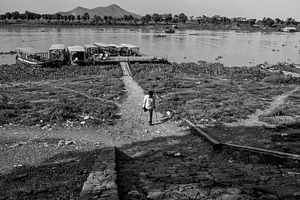Luc Forsyth and Gareth Bright have set out on a journey to follow the Mekong river from sea to source. The Diplomat will be sharing some of the stories they’ve found along the way. For more about the project, check out the whole series here.
* * *
“I need you to put me in a car and send me back to Phnom Penh,” Gareth said over the phone at 5 am. Our hotel rooms were only separated by a single flight of stairs, but it was clear from his drained voice that he didn’t have the strength to handle the short walk. In the mid-sized city of Kampong Chhnang, located on the western bank of Cambodia’s Tonle Sap river, the “A River’s Tail” project was about to suffer its first casualty.
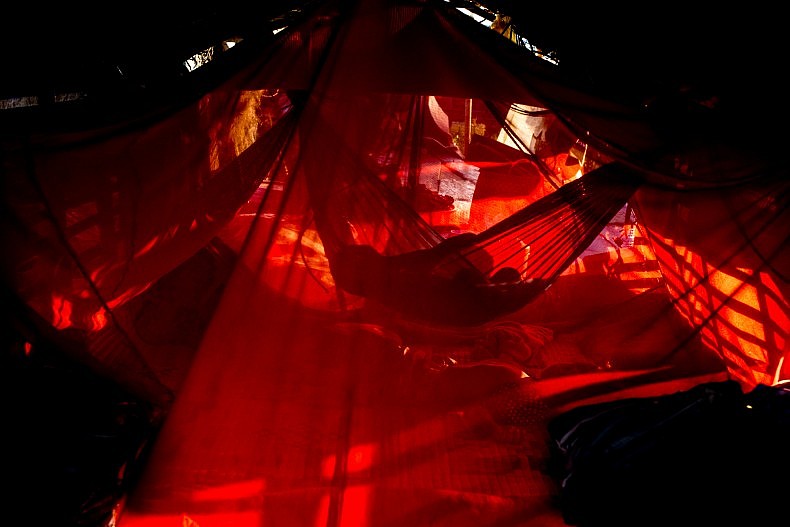
A young boy sleeps in a hammock inside his family’s house boat in the riverside city of Kampong Chhnang. Photo by Luc Forsyth.
We had taken a bus from Phnom Penh the day before, diverging from the Mekong to explore the Tonle Sap, and Kampong Chhnang was meant to be a brief stopover before taking a short boat ride to the remote riverside community of Tae Pi. Arriving in the late afternoon, we spent the remaining daylight hours wandering along the waterfront, shooting pictures of daily life and speaking to locals about the health of the all important waterway. They, like nearly everyone we had spoken to during our travels, told of declining fish stocks and the corresponding economic hardships.
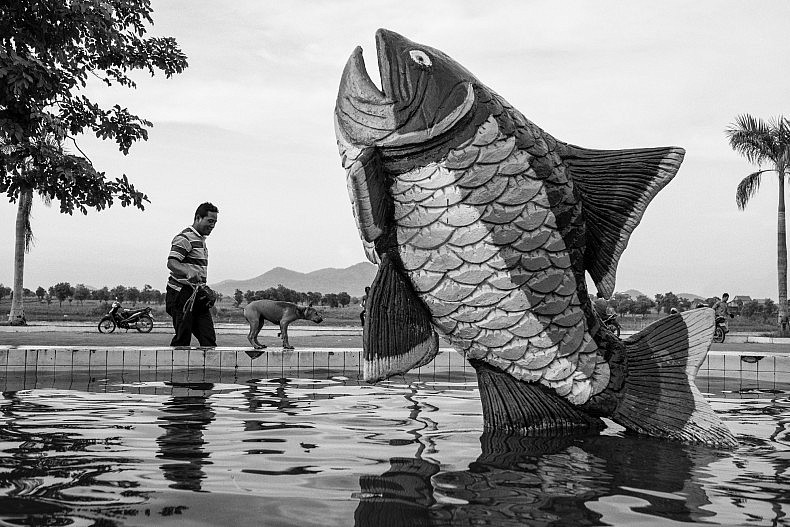
A man allows his dog to take a drink and eventually a dip in a public fountain in Kampong Chhnang along the town’s riverside promenade. Photo by Gareth Bright.
The lack of prosperity was plain. Despite being the most important river port between Cambodia’s two largest cities — Phnom Penh and Siem Reap — the city was shrouded in an air of lethargy, made all the more sluggish by the sweltering heat of the dry season. While people went about their daily tasks — mending fishing nets, loading manufactured goods onto waiting boats, and socializing along the promenade — the atmosphere was defined by a distinct lack of bustle.
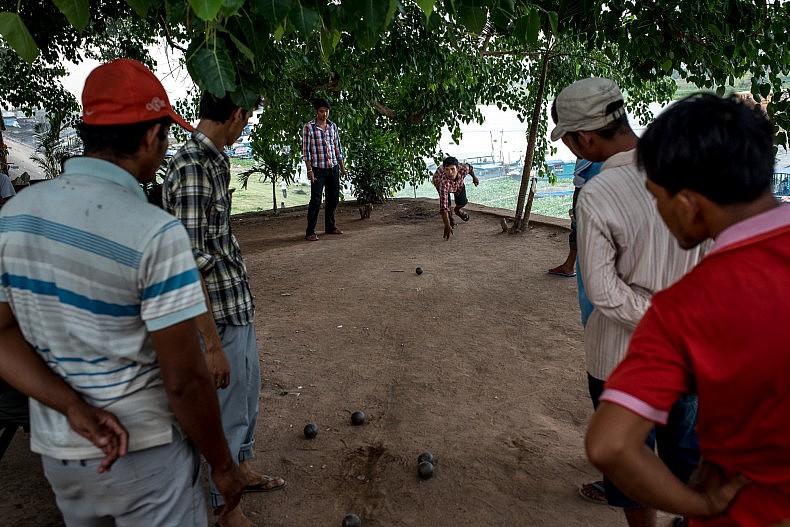
Locals in Kampong Chhnang play petanque, a French version of lawn bowling that was made popular in Cambodia during the French colonial period. Photo by Luc Forsyth.
As the sun set on the provincial capital, Gareth’s deterioration became increasingly apparent from his colorless face. Hoping that a long sleep in an air-conditioned room would restore him to health, we returned to our hotel earlier than usual. Yet when my phone rang the next morning I knew that it hadn’t worked. That early in the morning there were no taxi drivers available to pick him up, so I spent a few hours wandering along the banks of the river watching the city wake up as children arrived to school on water taxis.
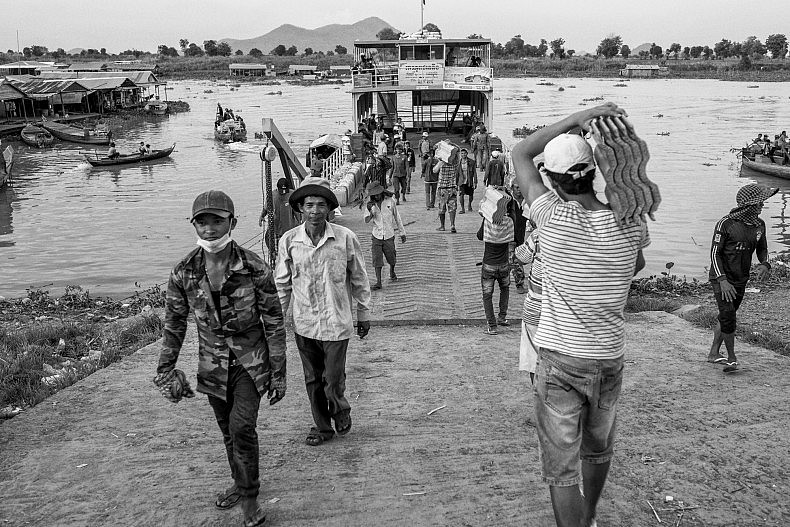
Workers carry ceramic tiles to a local ferry in the riverside city of Kampong Chhnang. Photo by Gareth Bright.
Eventually I managed to find a driver willing to take Gareth back to Phnom Penh, and I helped him settle into the backseat with two liters of water and a can of Coke. With Pablo locked in his office in the capital working feverishly to edit the video footage from the Vietnam leg of the project, for the first time since “A River’s Tail” began I was on my own.
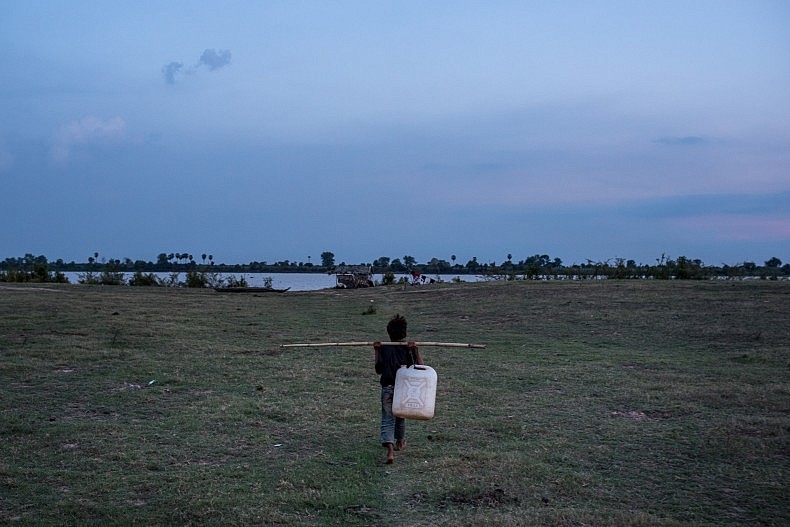
A young boy walks towards the Mekong to collect water for his family in the remote community of Tae Pi. During the dry season the river level can recede up to a kilometer away from resident’s homes. Photo by Luc Forsyth.
Old Friends and Parched Earth
The real reason we had stopped in Kampong Chhnang was so we could visit Jan Ta and her family, whom Gareth and I had met 7 months previously while driving a wooden fishing boat through Cambodia’s waterways. It was that three-week trip that was the foundation for what would become the “A River’s Tail” project, and meeting Jan Ta in the remote community of Tae Pi where she lived had been one of the highlights. When I called her again, even after more than half a year without contact, she immediately agreed to send her son to fetch me in Kampong Chhnang.
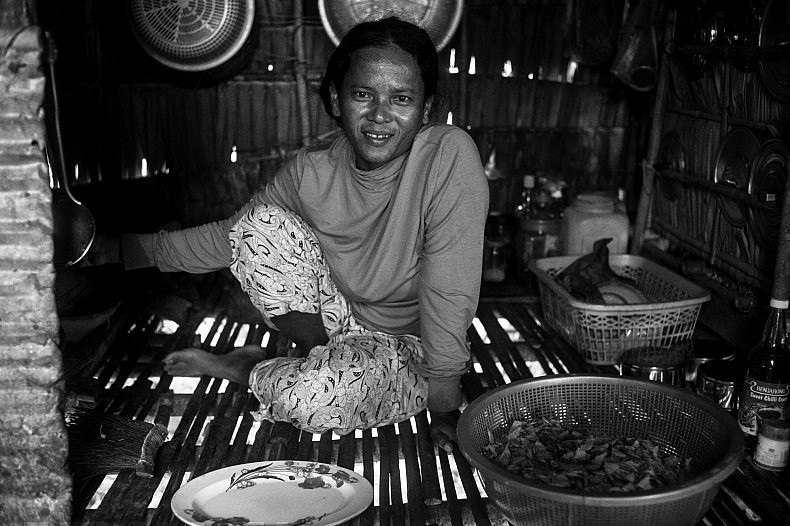
Jen Ta, a resident of the village of Tai Pi prepares an early morning breakfast of dried fish and rice for her family. Photo by Gareth Bright.
Our relationship had started by accident when Gareth and I, caught on the water as the sun set and desperate to find a place to spend the night, made an impromptu stop at a small cluster of homes along the river’s edge that we spotted through our binoculars. When we had pulled up to the shore, the initial reaction of the villagers had been one of suspicious apprehension: Who are you and what do you want? This was not a place that foreign tourists frequented, and the locals had eyed us warily. But after a series of phone calls to a Khmer friend who was able to explain that we were just seeking a place to sleep, the mood shifted immediately. All hostility vanished and the nearest villager, Jan Ta, had welcomed us into her home.
At that time, during the wet season when the river was at its highest level, Tae Pi had been a picture postcard of simple riparian life. A cluster of 30 families lived in stilted wooden houses along the river’s edge, fishing from the river and gathering aquatic vegetables and flowers to sell at nearby markets. The contrast that greeted me on my return could not have been more pronounced.
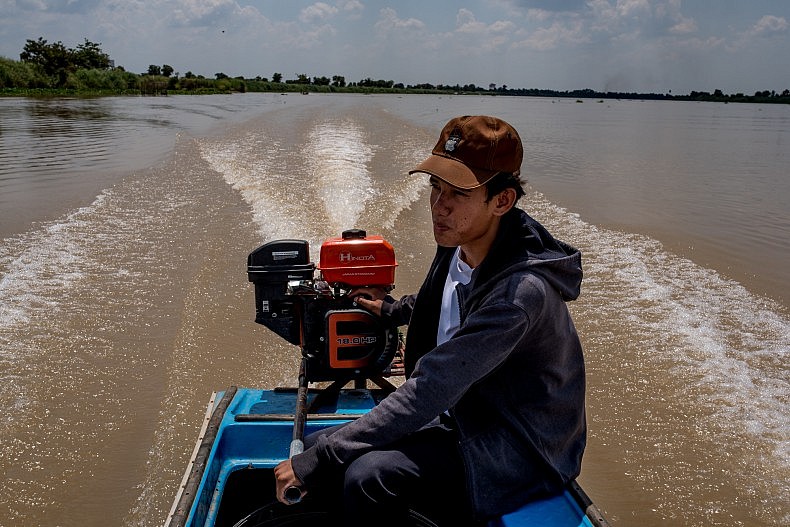
A teenager drives his boat between the city of Kampong Chhnang and the remote village of Tae Pi. Photo by Luc Forsyth.
As Jan Ta’s 16-year-old son throttled the engine of his boat to full speed and smashed through a thick barrier of lilies, I thought we were making a quick stop somewhere before continuing on to Tae Pi. There were no houses in sight, only a wide expanse of dry brown fields stretching for a kilometer or more towards a small mountain on the horizon. This did not in any way resemble the village I remembered, and it wasn’t until Jan Ta’s son tied the boat up to shore and beckoned me to follow that I understood that we had arrived. While I knew that Cambodia was subject to dramatic environmental changes between seasons, the transformation of the land rendered the area more unrecognizable than I could have imagined.
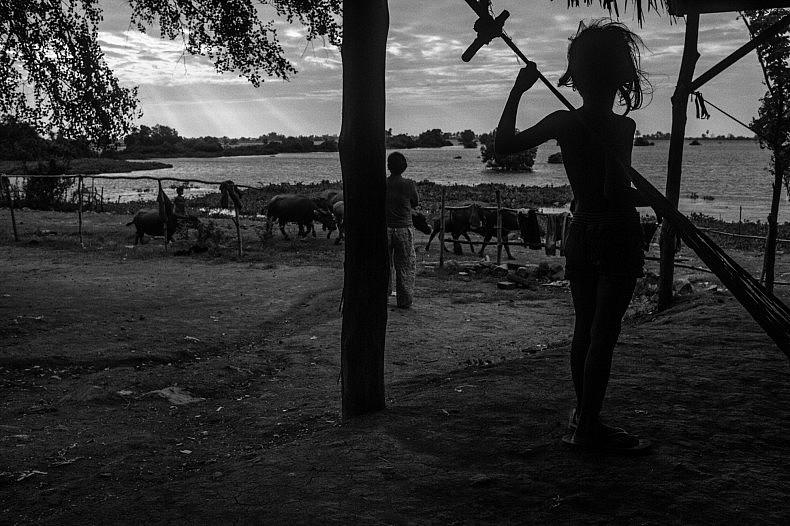
A young girl watches on as the small herd of cattle are herded early morning in remote village of Tae Pi. Photo by Gareth Bright.
Gone were the tightly knit clusters of fishermen and flower vendors that had exemplified Tae Pi on our last visit, and the conspicuous absence of people was somehow unsettling. After a 10 minute walk across fields so dry that the grass crunched audibly under foot, I arrived at Jan Ta’s house. She stood in the shade of a parched looking tree, smiling warmly in greeting. Some things, at least, had not changed.
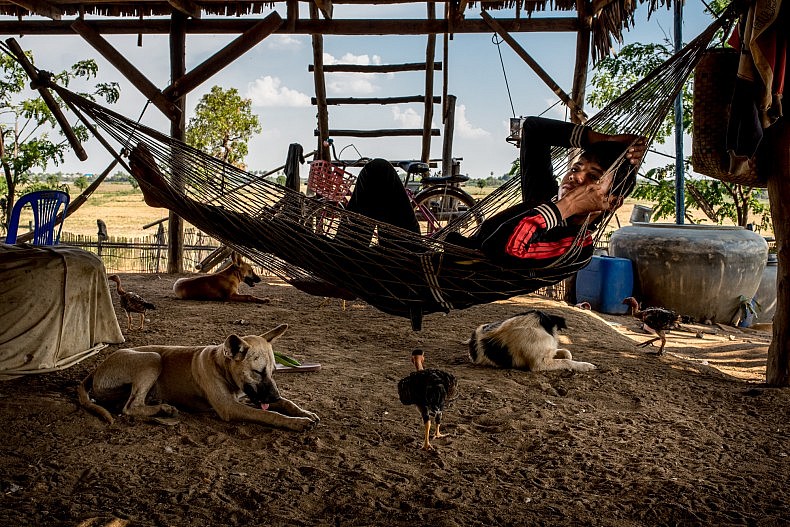
During the heat of the day, a teenager relaxes under the shade of his family home. Temperatures can approach 40 degrees Celsius (104 Fahrenheit) on a daily basis during the dry season. Photo by Luc Forsyth.
Dwindling Prospects
“The rainy season is much better,” Jan Ta said after I commented on the transformation of the village. “In the dry season I can’t earn any profits. It is impossible to catch fish, so I have to rent half a hectare of rice field just to have enough food.” Though she seemed genuinely happy to see me, there was a worn look on her face that I hadn’t seen the last time we’d met and I suspected that all was not well.
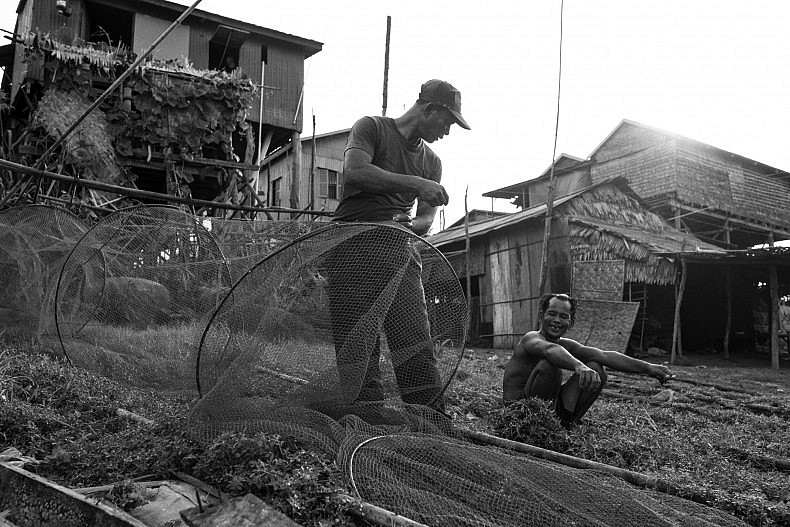
A soldier, who works part time as a fisherman to earn extra money, mends his nets in the riverside city of Kampong Chhnang. Photo by Gareth Bright.
“This place has completely changed in the last 10-20 years,” she told me, launching into a categorical list of her woes almost immediately upon my arrival: “People are using fishing nets so fine that no baby fish survive to grow up and be caught again. They are also using batteries to shock the water, which kills everything. The farmers now use chemicals on the rice, which goes into the water and poisons the fish.”
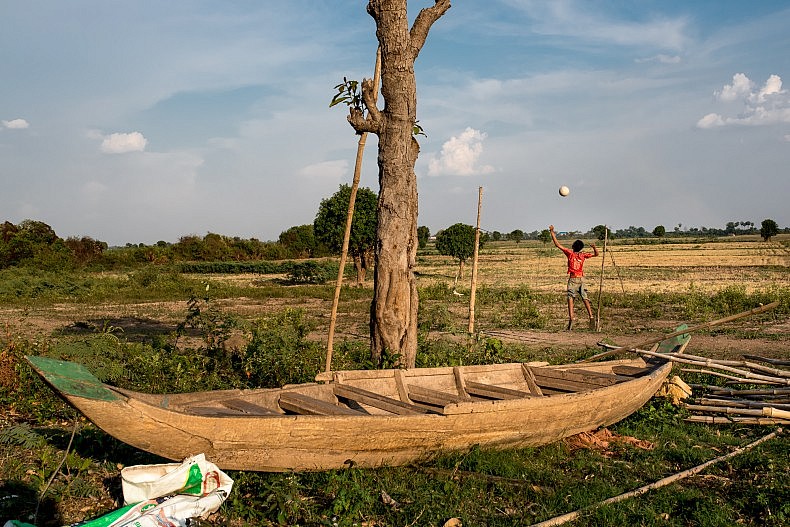
A teenage boy practices volleyball on a dry patch of ground in the remote village of Tae Pi. During the rainy season, these fields would be innundated by water. Photo by Luc Forsyth.
As Jan Ta spoke, I realized that the quaint memory I’d created of a community living in harmony with nature was an illusion. The drastic metamorphosis of the landscape only served to exacerbate the revelation that I had remembered the village as I had wanted to — a stereotypical idyllic memory that was rapidly being dispelled.
“I don’t know about the future of the river, but I can barely find anything in it these days,” Jan Ta continued. “If the river can’t support us now, I don’t have much hope for my kids. They will need to leave here and get a job somewhere else. I have already sent my eldest son to Phnom Penh to work in a garment factory so he can send money home.” A new reality of life along the Tonle Sap, one of the most important sources of fertility for the Mekong, was taking shape. And like most of the stories we had found during our travels thus far, the overall picture was not good.
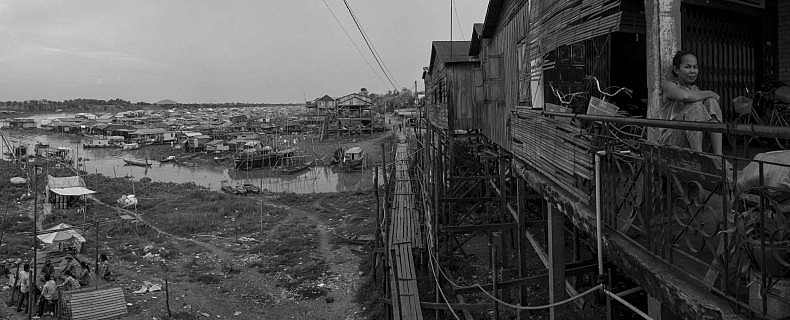
A woman sits in on the porch of her stilled house in riverside town of Kampong Chhnang, Cambodia. Photo by Gareth Bright.
I left Jan Ta’s house for a few hours to walk through the village, hoping that some time alone would allow me to make the necessary adjustments to my perception of a place I had once thought so timelessly quaint. I realized that I had made the mistake common to so many travelers: in my eagerness to see what I wanted to see I hadn’t been critically objective in my observations. I had tricked myself into thinking Tae Pi was a model for how people could live happily from the bounties of nature. The truth was that these people, like so many others along the Mekong and its distributaries, were reeling from the consequences of the human overexploitation of the river’s finite resources — resources that were clearly at their breaking point.
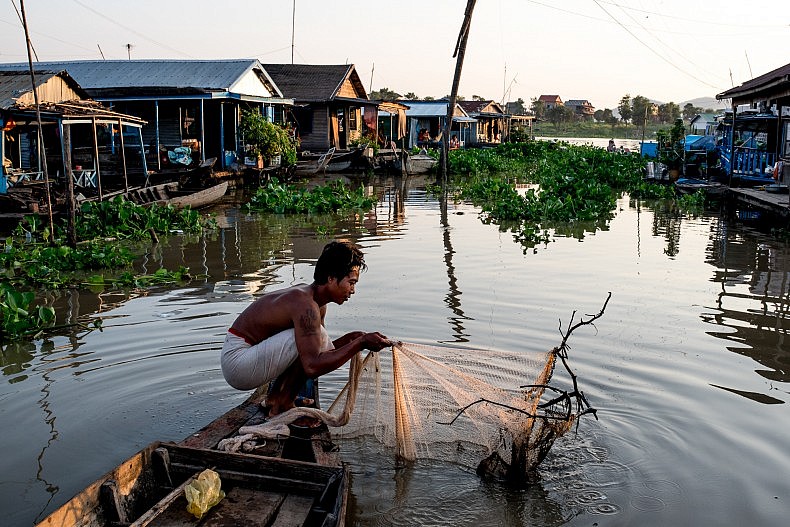
A fisherman catches his net on a sunken tree branch while fishing in the early morning in the city of Kampong Chhnang. Photo by Luc Forsyth.
That night Jan Ta prepared a meal of rice, fried fish, and eggs, ever the good host despite the obvious challenges her family was facing. I tried not to let the pervading sense of sadness, which I had felt since readjusting my views on the realities life in this remote village, come through; but Jan Ta seemed to see through me.
“I like it here,” she said. “Even if it is impossible for me to earn enough money, I will stay.”
This piece originally appeared at A River’s Tail.













